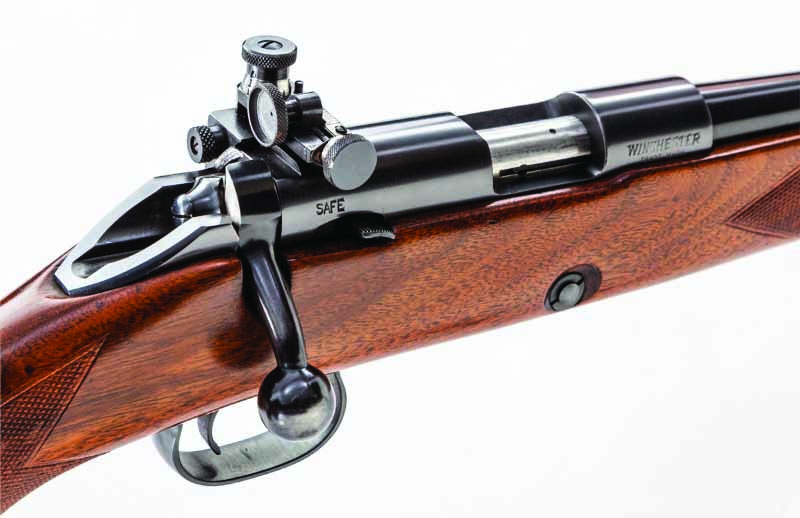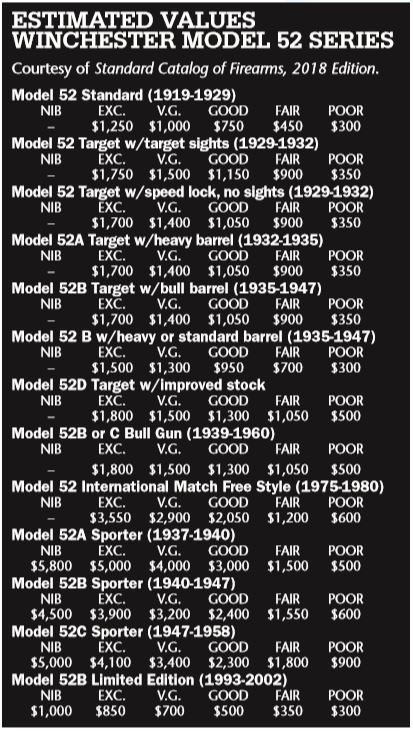

Celebrating its 100th anniversary, the Winchester Model 52 remains among the rimfire royalty.
Why the Winchester Model 52 Still Remains Highly Desirable:
- Highly accurate rimfire that, early in its history, dominated small-bore competitions.
- Original design included receiver machined from a forging, a non-rotating bolt, a 28-inch heavy-contour barrel.
- It also had a unique button magazine release.
- Extremely fast lock time, contributing to the rifle’s already excellent accuracy.
- Among the rarest and most collectible version is the Model 52 Sporting Rifle.
The 100th anniversary of the “King of .22 Caliber Rifles,” the Winchester Model 52, is upon us. Although it didn’t go into production until 1920, in August of 1919, six pre-production samples of the Model 52 were issued to several shooters at the National Rifle Matches in Caldwell, New Jersey. Soon, the Model 52 was dominating the world of small-bore competition. Winchester ads called it “the greatest small bore rifle ever placed on the market.”
Following World War I, Winchester recognized that American shooters were showing a preference for bolt-action rifles. Work began on designing a new rifle for rimfire match shooting. Winchester engineer, T.C. Johnson, received most of the credit for coming up with what became the Model 52, but he was assisted by another designer, Frank Burton.
Features of the original design included a receiver machined from a forging, a non-rotating bolt, a 28-inch heavy-contour barrel with target sights and a barrel band, a wing-type safety on the left side of the receiver, and a unique magazine release consisting of a button on the right side of the stock adjacent to the magazine.
More Gun Collecting Info:
- The Walther PP Series
- The Quintessential 22 Pistol: The Colt Woodsman
- The Rocky History Of The L.C. Smith
- The Browning SA-22
- Colt Python: The Cadillac Of Revolvers
The Model 52 was made in several variations over the 60 years it was in production, between 1919 and 1979. Winchester advertised that the Model 52 with its 28-inch barrel had the “same feel” as the Springfield military rifle, directing that claim to the veterans of WWI. In 1929, the finger grooves were eliminated and a new trigger and firing pin design called the Speed Lock was introduced, replacing the two-stage military-style trigger of the original model. Designed by Frank Burton, it reduced the lock time between the pull of the trigger and ignition of the primer, contributing to the rifle’s already excellent accuracy.

In the early 1930s, a reinforced receiver and locking lug were added, and the model became the Model 52A. Minor changes came in 1935, including a single-shot adapter and adjustable sling swivels, and the model designation became the Model 52B. After World War II, the Model 52C was unveiled with a new vibration-free trigger mechanism that was easily adjustable. Other changes came along including single-shot models, extra-heavy bull barrels, free-style stocks (including a thumb hole) and adjustable buttplates and forends.
The rarest — and what later became the most highly collected version of the Model 52 — was introduced to the shooting public in 1934. Winchester president John Olin was a big fan of the 52 Target rifle, and when a friend showed Olin his rifle that had been mounted in a handsome “sporting” stock, he was very impressed. Olin quickly authorized the development of the Model 52 Sporting Rifle, or Sporter. It had the look and feel of a “big game” rifle with its highly figured hand-checkered walnut stock complete with cheekpiece, high comb and black forend tip. The 24-inch lightweight barrel had a Lyman 48 receiver rear and a hooded ramp front sight, though sights from other makers were also available. The initial price for the Sporter was $88.50, which was a rather hefty amount in the middle of the Great Depression.

Approximately 125,200 Model 52s of all variations were made. Each improvement and upgrade in the M52 Target Rifles were also included in variants of the Sporter model. The Sporter was a variation of the Model 52 Target Rifle and its serial numbers were not a separate series: They were mixed in with those for the target models. This makes it impossible to know how many Model 52 Sporters were made. I have seen estimates in the 5,700 to 5,800 range but these are based on guesses from various sources.
The only series with an accurate number is the Model 52C, the last ones produced. According to Herbert Houze’s excellent book, The Winchester Model 52 — Perfection In Design, there were 1,314 Sporter C models made between 1954 and 1960, when the model was discontinued. The C series is generally considered by collectors to be the finest of the Sporting models.
Winchester was lobbied for years by shooters and outdoor writers to bring back the Model 52 Sporter. In 1991, the FN/Herstal Group, parent company of Winchester and Browning, introduced a “reissue” of the Model 52B, made by Miroku in Japan. It was first made under the Browning name from 1991 to 1992, and then under the Winchester brand from 1993 to 2002. These are excellent rifles and approximate the look and feel of the original 52 Sporter, but they are replicas and not exact copies of the original.
Editor's Note: This article originally appeared in the November 2018 issue of Gun Digest the Magazine.

Next Step: Get your FREE Printable Target Pack
Enhance your shooting precision with our 62 MOA Targets, perfect for rifles and handguns. Crafted in collaboration with Storm Tactical for accuracy and versatility.
Subscribe to the Gun Digest email newsletter and get your downloadable target pack sent straight to your inbox. Stay updated with the latest firearms info in the industry.

![Best Concealed Carry Guns In 2025 [Field Tested] Wilson Combat EDC X9S 1](https://gundigest.com/wp-content/uploads/Wilson-Combat-EDC-X9S-1-324x160.jpg)


![Best 9mm Carbine: Affordable PCCs [Tested] Ruger Carbine Shooting](https://gundigest.com/wp-content/uploads/Ruger-Carbine-Shooting-100x70.jpg)
![Best AR-15: Top Options Available Today [Field Tested] Harrington and Richardson PSA XM177E2 feature](https://gundigest.com/wp-content/uploads/Harrington-and-Richardson-PSA-XM177E2-feature-100x70.jpg)
